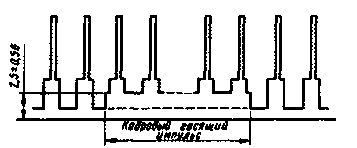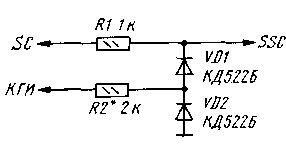
|
|
ENCYCLOPEDIA OF RADIO ELECTRONICS AND ELECTRICAL ENGINEERING On the difficulties of modernizing TVs. Encyclopedia of radio electronics and electrical engineering
Encyclopedia of radio electronics and electrical engineering / Телевидение When repairing and improving old domestic TVs, especially when replacing individual blocks with new, more reliable and modern ones, problems may arise, in particular, with the use of three-level pulse signals (strobe pulses) in the latter. How to solve them, you will learn from the article published here. Three-level pulse signals for controlling and synchronizing the operation of the constituent units have long been used in consumer video equipment. Ignorance or ignoring this fact sometimes brings a lot of trouble during its modernization or repair. Why did developers use more complex command signals? At first glance, this is a clear deviation from the principle of continuity and unification of blocks of the same purpose. However, from time to time life forces us to make such radical changes. The developers themselves motivate this by reducing the number of pins of microcircuits and connections between blocks, as indicated in the book by B. N. Khokhlov "Decoding Devices for Color TVs" (M .: Radio and communication, 1992). For example, the PANASONIC NV-SD300AM video recorder contains the AN3553FBR color processor, which has 84 pins coming out of the case on four sides. Obviously, there are reasons to fight to reduce their number. By the way, for example, pin 53 of this microcircuit serves as a three-level command input for selecting one of the three video signal color processing standards. In domestic TVs, the strobe pulse known to many for the color block of second-generation devices was two-level. It was designated as the SC signal. Personnel quenching pulses arrived at the color block through a separate wire and the contact of the interblock connector. Then, in some third-generation models and in all fourth-generation TVs, they completely switched to three-level strobe signals, which also contain a vertical quenching pulse, as shown in Fig. one.
Three-level strobe signals began to designate SSC and called super strobe (super sand castle). Inside the microcircuit (color processor), this signal is analyzed in a special decoding node by levels, and the received pulses are sent to those parts of the microcircuit where they are needed. When modernizing TVs, and especially the color path, it is precisely the compatibility problems of blocks of different generations that arise. And such an upgrade is often very necessary for some models. For example, this applies to the Horizont-355 TV, in the color block of which very capricious hybrid microassemblies on ceramics are used. Moreover, the radio channel block remains quite reliable. Of course, every radio amateur - the owner of a TV - seeks to remake it at minimal cost. It is this version of modernization that presents the greatest difficulties. Firstly, the color and radio channel blocks (using the specified TV as an example) are located on one common board, and they must be carefully separated along the perforation holes without damaging the radio channel block. Secondly, a new interconnect is needed, which combines the new color block with the old radio channel and with a common backplane. At the same time, it turns out that the fourth generation color block board does not contain video amplifiers and therefore it is necessary to replace the kinescope board with a new one, where they are available. In addition, it turns out that the new chrominance block no longer needs a vertical quenching pulse. However, one should not rush to conclusions. If the image on the screen acquires visible streaks of reverse beams and somewhat distorted colors, then there are clearly not enough frame quenching pulses. This is where the main difficulty lies in the modernization. The fact is that on the oscillogram (Fig. 2), the SC signal looks the same as the SSC due to the rarer appearance of a vertical quenching pulse in a three-level signal (a barely distinguishable thin horizontal line in the lower wide part of the pulse, shown in the figure by a dashed line).
To obtain the SSC signal, it is necessary to add vertical quenching pulses to the SC signal using a simple node, the diagram of which is shown in Fig. 3. It is assembled by surface mounting on the A3 interconnect board as shown in fig. 4 (the point of connection of diodes and resistor R2 is above the board). To do this, remove the jumper connected to pin 4 of connector X4 (A2), and instead solder the resistor R1 of the node. Points with signals SC, THD and a common wire are located in the immediate vicinity of the removed jumper. All you have to do is drill one or two additional holes in the board.
If you do not have an oscilloscope, then a variable resistor with a resistance of 2 kOhm is temporarily soldered in series with the resistor R10, and its slider is set to the minimum resistance position. When adjusting, the engine is rotated until the return lines of the rays on the received picture disappear, that is, until the normal color image is restored on the screen. Then they measure the total resistance of the resistors (constant and variable) and solder instead of them a constant with a resistance of about 5 ... 10% more than the measured one. If you have an oscilloscope, you need to synchronize it with a pulse from the output of the shaper node and achieve (with a variable resistor) that a thin horizontal line passing through the entire synchronized SSC pulse drops down to its wide part (see Fig. 2) and takes position approximately 2 /3 from the height of this part. However, the modernization does not end there. It is also necessary to pair the brightness, contrast and color adjustments with the new block. It seems that for a radio amateur who has ventured into such a remake, the last stage will no longer be a big problem. Author: S. Tuzhilin, Moscow; Publication: N. Bolshakov, rf.atnn.ru
Traffic noise delays the growth of chicks
06.05.2024 Wireless speaker Samsung Music Frame HW-LS60D
06.05.2024 A New Way to Control and Manipulate Optical Signals
05.05.2024
▪ Charging station Bluetti AC180 ▪ Samsung 20nm mobile DRAM chips ▪ The radar is battery powered. ▪ Servers based on Intel Xeon processors
▪ site section Power supplies. Article selection ▪ article Hot water at any time. Tips for the home master ▪ How did the turning point occur during World War II? Detailed answer ▪ article Caterpillar motorcycle. Personal transport ▪ article Automatic engine heater. Encyclopedia of radio electronics and electrical engineering ▪ article A square of four cards that are not repeated in a row and row. Focus Secret
Home page | Library | Articles | Website map | Site Reviews www.diagram.com.ua |






 Arabic
Arabic Bengali
Bengali Chinese
Chinese English
English French
French German
German Hebrew
Hebrew Hindi
Hindi Italian
Italian Japanese
Japanese Korean
Korean Malay
Malay Polish
Polish Portuguese
Portuguese Spanish
Spanish Turkish
Turkish Ukrainian
Ukrainian Vietnamese
Vietnamese




 Leave your comment on this article:
Leave your comment on this article: